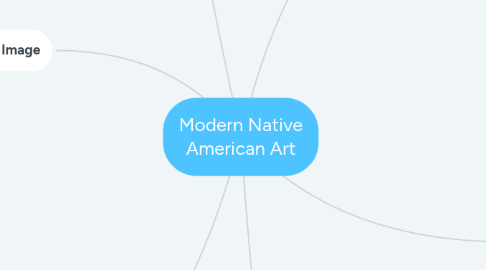
1. European Colonization
1.1. Roxanne Dunbar-Ortiz and Dina Gilio Whitaker “All the Real Indians Died Off"
1.1.1. This source relays the myth that Native Peoples of the Americas disappeared after white settler colonialism. This erasure of modern and historic peoples works to invisibalize their presence to cover up harm being done.
1.2. Artist: Jaune Quick-To-See Smith
1.2.1. Juane Quick-To-See Smith is a modern artist out of Montana who is from the Confederated Salish and Kootenai Nation. She uses mixed media to speak of colonialism imposing itself over tribal lands and shedding blood of natives peoples to perpetuate images of whiteness and compartmentalize and appropriate that of natives.
1.3. Bastard Fairies “The Canary Effect”
1.3.1. This film addresses the atrocities committed against various indigenous nations across the United States upon the arrival of European Colonists. They committed blatant genocide on multiple accounts as well as indoctrination of their European/religious values upon the Native Peoples. This attack on the livelihoods of indigenous people has continued today and transformed into other oppressive and deadly forms.
2. Transforming the Native Image
2.1. Fritz Shoulder: Indian / Not Indian
2.1.1. He is a late artist who made his mark around the 1960s of Santa Fe's art scene. He revolutionized native expression, standing up to imposed colonial frameworks of how native art "should" look. He stepped into his artist identity as half native american and was an early advocate for recognition of intersectionality in art. He famously "painted the indian" in bright colors and with all the charm and expression he had to engage with.
2.2. “The Gaze in Indigenous Art: Depictions of the Body and Nudity” by Nancy Marie Mithlo
2.2.1. In the Text, "Making History" One chapter presents various artistic depictions of the body and how it is represented throughout various native cultures. These works have given access to different experiences and attitudes of the body. For example, the honest and tired depiction of a woman at old age, within a wrinkled and settled body. Or another image of a nude woman with her tattos pointing her gaze fiercly at her onlooker.
3. Kinship
3.1. Robin Wall Kimmerer “The Intelligence of Plants”
3.1.1. In this 50 minute podcast, Robin Wall Kimmerer delves into her native perspective on the intersectionality between science, art and spirituality. She speaks to the necessity for environmental recognition beyond impersonal pronouns such as "it." if referring to something such as a plant. By observing our environment from a framework of kinship, we are able to respect the complex multitudes of that which we do know about the earth from science as well as all of which we have not yet discovered.
3.2. Deloria, Ella Cara, and Vine Deloria "Speaking of Indians: Kinships Role in Dakota Life."
3.2.1. This document examens attitudes adopted under the framework of kinship within the dakota communities. People have extended connectivity through family and assigned family, so accountability and community are pincical to am amicable living environment. All people are held accountable for their actions but through a means of inescapable love and indebted reliability. If a member of this community wrongs another person or aspect of community, they are not ostracized but rather, more closely integrated.
4. Boarding Schools
4.1. Bastard Fairies called “The Canary Effect”
4.1.1. Touched on the formation of boarding schools effort to homogenize native people into a culturally "white" group. These boarding schools stripped children of their families at ages as early as 3. This ensured the loss of certain customs, language and identity. Many children did not leave the boarding schools and died there, never to see their families again.
4.2. Pablita Valarde “Golden Dawn: The Pueblo Paintings of Pablita Velarde”
4.2.1. Pablita Valarde is an artist who was recruited by the Santa Fe Indian school with an offer of a better life than with her people. She was sought out due to her passion for painting and well known individual within her community as one of the only women to paint. In this environment, she was taught how to paint as white people thought Indians should and to recreate what she knew in her community. She is very renowned but is a keen example of someone who was put through this educational system and represents that period of time.
5. Stereotypes
5.1. Shelly Niro “Honey Moccasin"
5.1.1. In this film by Shelly Niro, gender and indigenous stereotypes were explore mainly through the antagonist, Zachary. He is compartmentalized initially as a thief and ungenuine to those in his community. But has his character arcs, the viewer has insight as to his struggle with wanting to be transgender and how repression of self expression is sometimes misinterpreted by those who don't understand someone's situation.
5.2. “This Video Essay Was Not Built On An Ancient Indian Burial Ground: Examining Horror Aesthetics in Indigenous Cinema"
5.2.1. In this short film, many tropes are explored in depictions of natives throughout the history of film. The narrator, Macabria is the first exploration of stereotypes as she is purposefully made out to be hypersexualized as many native women have been portrayed as in the white oppressive gaze. This exploration of horror further unpacks stereotypes of scandalous Indians, ancient indian burial grounds as a source for paranormal or evil phenomenons and the false sense of envy that "native peoples have toward whiteness."
6. Reading the Visual Record
6.1. Elspeth Brown, “Reading the Visual Record”
6.1.1. This document sheds light on the necessity for keen visual evaluation and potential external research necessary in order to dissect a piece of Native Art. Frequently, symbols within a nation are perpetuated through iconography within an artists work. If an onlooker does not understand the relationship between symbolism and the community in which the art origionated, it's frequent that misinterpretation can take place. But for people who do read these iconographic images and symbols, art work ties people to universal truths, communal tales and other massages.
